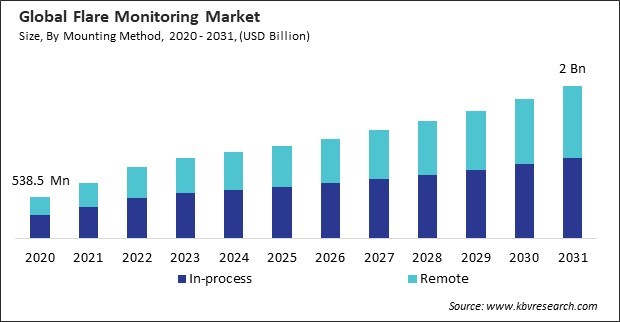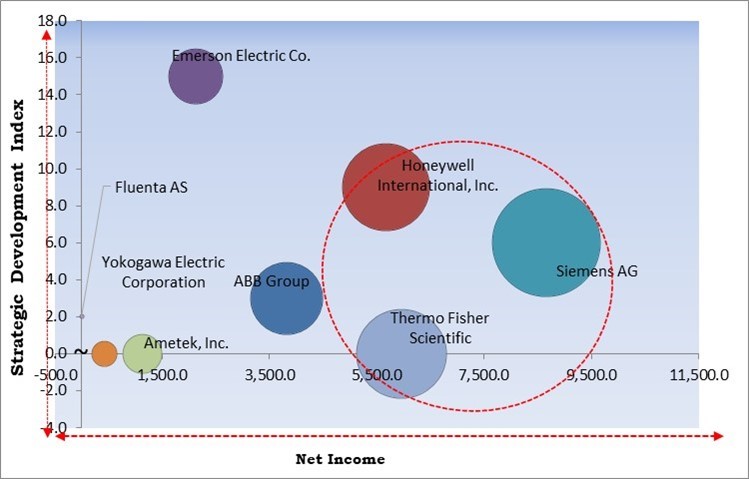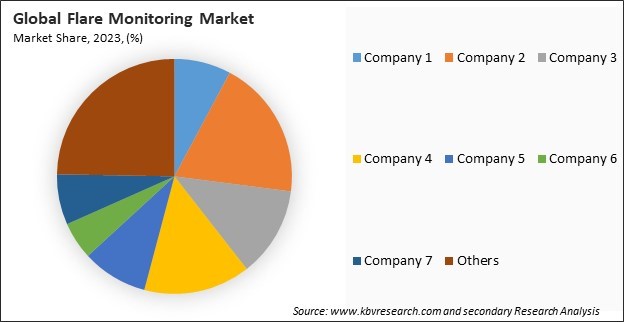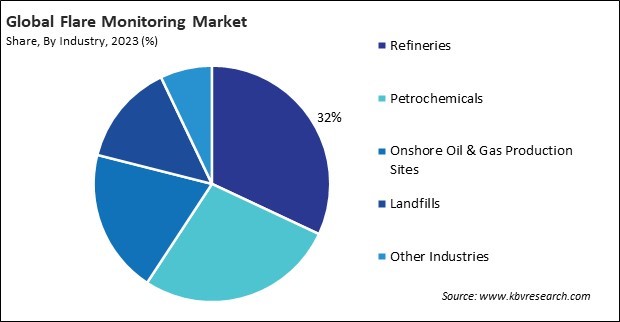“Global Flare Monitoring Market to reach a market value of USD 2 Billion by 2031 growing at a CAGR of 8.5%”
The Global Flare Monitoring Market size is expected to reach $2 billion by 2031, rising at a market growth of 8.5% CAGR during the forecast period.
Environmental laws in this region are very harsh, notably those that are implemented by the Industrial Emissions Directive (IED) of the European Union. This region is differentiated by these rules. Refineries, oil and gas companies, and petrochemical companies are among the businesses that are required to comply with this directive's tight restrictions on flare emissions. Consequently, the European region would acquire nearly 28% of the total market share by 2031.

The major strategies followed by the market participants are Product Launches as the key developmental strategy to keep pace with the changing demands of end users. For instance, In July, 2024, Ametek, Inc. introduced the LWIR-640 thermal imager for battery storage, advancing fire prevention with early detection of thermal runaway. Features include precise temperature measurement, continuous monitoring, alarm triggering, and data logging, ensuring proactive safety and seamless system integration. Moreover, in November, 2023, Emerson Electric Co. introduces the Fisher FIELDVUE DPC2K digital process controller, enhancing pneumatic controllers with improved closed-loop control, reliability, and safety. It features extensive remote connectivity, easy maintenance, and versatile applications for pressure, flow, level, and temperature control in hazardous environments.
Based on the Analysis presented in the KBV Cardinal matrix; Siemens AG, Honeywell International, Inc. and Thermo Fisher Scientific are the forerunners in the Market. In December, 2023, Siemens announced the launch of enhanced fire safety solutions for its Building X platform. The introduction of new applications and an API significantly boosts remote monitoring, real-time notifications, and predictive maintenance capabilities. These advancements enhance transparency, operational efficiency, and sustainability, optimizing data management and reducing CO2 emissions from site visits. Companies such as Emerson Electric Co. and ABB Group are some of the key innovators in Market.

Infrared (IR) and ultraviolet (UV) sensing technologies have greatly enhanced the precision and dependability of these systems, allowing industries to detect even the smallest emissions. The improvements in sensor technology have driven the widespread adoption of these systems, particularly in emission-heavy industries such as oil and gas, petrochemicals, and refineries. Hence, the continuous evolution of monitoring technologies, particularly in sensor capabilities, is a key factor propelling the growth of the market.
With considerable expansion in a variety of regions, particularly in the Middle East, North America, and Asia, the oil and gas industry around the world is continuing to expand and see tremendous growth. Furthermore, the Russian Federation, the Islamic Republic of Iran, Iraq, the United States, República Bolivariana de Venezuela, Algeria, Libya, Nigeria, and Mexico remain the top nine flaring countries in 2023. Thus, as the global energy demand grows, the market will continue to expand.
Cutting-edge systems like infrared sensors, mass spectrometry, and optical gas imaging require substantial capital to purchase, configure, and integrate into existing infrastructure. Small and medium-sized enterprises frequently operate with restricted financial resources and are more susceptible to capital-intensive investments. Hence, the high cost of these technologies has emerged as a key factor obstructing market growth.

The leading players in the market are competing with diverse innovative offerings to remain competitive in the market. The above illustration shows the percentage of revenue shared by some of the leading companies in the market. The leading players of the market are adopting various strategies in order to cater demand coming from the different industries. The key developmental strategies in the market are Product Launches and Product Expansions.
Based on industry, the market is segmented into refineries, petrochemicals, onshore oil & gas production sites, landfills, and others. The petrochemicals segment acquired 27% revenue share in the market in 2023. Petrochemical plants are responsible for the production of a wide variety of chemicals that are obtained from natural gas and petroleum.

Based on mounting method, the market is bifurcated into in-process and remote. The remote segment procured 44% revenue share in the market in 2023. Remote monitoring systems are gaining traction because they offer non-invasive methods of tracking flare emissions from a distance.
Free Valuable Insights: Global Flare Monitoring Market size to reach USD 2 Billion by 2031
Region-wise, the market is analyzed across North America, Europe, Asia Pacific, and LAMEA. The North America segment recorded 34% revenue share in the market in 2023. The oil and gas industry's substantial presence in the United States and Canada is the primary reason for this dominance, as it is responsible for a substantial portion of global flare emissions.

The competition in the Market is growing, with established players focusing on advanced technologies for accurate emissions tracking and compliance. Rising environmental regulations are driving innovation, while smaller companies explore cost-effective solutions. Strategic collaborations and regional expansions are key factors intensifying the competitive landscape.
| Report Attribute | Details |
|---|---|
| Market size value in 2023 | USD 1 Billion |
| Market size forecast in 2031 | USD 2 Billion |
| Base Year | 2023 |
| Historical Period | 2020 to 2022 |
| Forecast Period | 2024 to 2031 |
| Revenue Growth Rate | CAGR of 8.5% from 2024 to 2031 |
| Number of Pages | 289 |
| Number of Tables | 473 |
| Report coverage | Market Trends, Revenue Estimation and Forecast, Segmentation Analysis, Regional and Country Breakdown, Competitive Landscape, Market Share Analysis, Porter’s 5 Forces Analysis, Company Profiling, Companies Strategic Developments, SWOT Analysis, Winning Imperatives |
| Segments covered | Mounting Method, Industry, Region |
| Country scope |
|
| Companies Included | Ametek, Inc., Emerson Electric Co., Siemens AG, ABB Group, Honeywell International, Inc., Thermo Fisher Scientific, Yokogawa Electric Corporation, Fluenta AS, Zeeco, Inc. and John Zink Company, LLC |
By Mounting Method
By Industry
By Geography
This Market size is expected to reach $2 billion by 2031.
Technological advancements in monitoring systems are driving the Market in coming years, however, High initial investment costs restraints the growth of the Market.
Ametek, Inc., Emerson Electric Co., Siemens AG, ABB Group, Honeywell International, Inc., Thermo Fisher Scientific, Yokogawa Electric Corporation, Fluenta AS, Zeeco, Inc. and John Zink Company, LLC
The expected CAGR of this Market is 8.5% from 2024 to 2031.
The In-process segment led the Market by Mounting Method in 2023; thereby, achieving a market value of $1 billion by 2031.
The North America region dominated the Market by Region in 2023, and would continue to be a dominant market till 2031; thereby, achieving a market value of $634.9 million by 2031.
Our team of dedicated experts can provide you with attractive expansion opportunities for your business.

 Drivers
Drivers
 Restraints
Restraints
 Opportunities
Opportunities
 Challenges
Challenges
